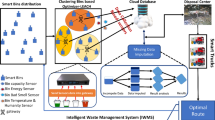Abstract
The fast development of Internet of Things (IoT) has greatly driven the development of mobile crowdsensing vehicular sensor network (CVSN). A lot of fascinating big data–based applications have been developed such as traffic management, health monitoring, and smart city. How to effectively collect enough data while not increasing too much redundancy is still a challenging problem in the big data application for CVSN. In this paper, a data relay mule–based collection scheme (DRMCS) is proposed to improve the quality of service (QoS). Comparing with the previous researches, the innovation of DRMCS is as follows: First, a data collection framework which considers the sensing task completion rate, redundancy rate and delay is proposed. Second, the micro mobile data center (MMDC) is proposed to solve the problem of connecting the huge number of intelligent sensing devices with data centre. Third, a MMDC selection strategy based on simulated annealing algorithm is proposed by DRMCS to improve the data collection performance. Compared with traditional vehicular network opportunistic communication without data relay mule (OCDRM), the sensing task completion rate of DRMCS has been improved by 78.6%.























Similar content being viewed by others
References
Liu Q, Hou P, Wang G, Peng T, Zhang S (2019) Intelligent route planning on large road networks with efficiency and privacy. J Parallel Distr Comp 133:93–106
Li T, Liu W, Wang T, Zhao M, Li X, Ma M (2020) Trust data col-lections via vehicles joint with unmanned aerial vehicles in the smart internet of things. Transactions on emerging telecommunications technologies, https://doi.org/10.1002/ett.3956, 2020
Cheng H, Xie Z, Wu L, Yu Z, Li R (2018) Data prediction model in wireless sensor networks based on bidirectional LSTM. EURASIP J Wirel Commun Netw 2019(1)
Wang T, Cao Z, Wang S, Wang J, Qi L, Liu A, Xie M, Li X (2019) Privacy-Enhanced Data Collection Based on Deep Learning for Internet of Vehicles. IEEE Trans Ind Inform 16:2019–6672. https://doi.org/10.1109/TII.2019.2962844
Huang M, Zhang K, Zeng Z, Wang T, Liu Y (2020) An AUV-assisted data gathering scheme based on clustering and matrix completion for smart ocean. IEEE Internet Things J:2020. https://doi.org/10.1109/JIOT.2020.2988035
Wang J, Wang F, Wang Y, Zhang D, Lim BY, Wang L (2018) Allocating heterogeneous tasks in participatory sensing with diverse participant-side factors. IEEE Trans Mob Comput 14(8):1979–1991
Stergiou C, Psannis KE, Kim BG, Gupta B (2018) Secure integration of IoT and cloud computing. Futur Gener Comput Syst 78:964–975
Kumari S, Chaudhry SA, Wu F, Li X, Farash MS, Khan MK (2017) An improved smart card based authentication scheme for session initiation protocol. Peer Peer Netwo Appl 10(1):92–105
Jiang B, Huang G, Wang T, Gui J, Zhu X (2020) Trust based energy efficient data collection with unmanned aerial vehicle in edge network. Trans Emerg Telecommun Technol. https://doi.org/10.1002/ett.3942
Wang T, Luo H, Zeng X, Yu Z, Liu A, Sangaiah A (2020) Mobility based trust evaluation for heterogeneous electric vehicles network in smart cities. IEEE Trans Intell Transp Syst:2020–2010. https://doi.org/10.1109/TITS.2020.2997377
Cueva-Fernandez G, Espada JP, Garcia-Diaz V, Garcia CG, Garcia-Fernandez N (2014) Vitruvius: an expert system for vehicle sensor tracking and managing application generation. J Netw Comput Appl 42(2014):178–188
Thiagarajan A, Ravindranath L, LaCurts K, et al (2009) VTrack: accurate, energy-aware road traffic delay estimation using mobile phone. Proceedings of the 7th ACM Conference on Embedded Networked Sensor Systems, pp. 85-98
"Waze - outsmarting traffic, together", 2013. [Online]. Available: http://www.waze.com/
Wang J, Wang F, Wang Y et al (2018) Social-network-assisted worker recruitment in mobile crowd sensing. IEEE Trans Mob Comput 14(8):1661–1673
Zhu W, Guo W, Yu Z, Xiong H (2018) Multitask allocation to heterogeneous participants in mobile crowd sensing. Wirel Commun Mob Comput 2018:1–10
Kuang Z, Li G, Zhang L, Zhou H, Li C, Liu A (2020) Energy efficient mode selection, base station selection and resource allocation algorithm in D2D heterogeneous networks. Peer Peer Netwo Appl. https://doi.org/10.1007/s12083-020-00915-4
Xie K, Wang L, Wang X, Xie G, Wen J (2018) Low cost and high accuracy data gathering in WSNs with matrix completion. IEEE Trans Mob Comput 17(7):1595–1608
Bazzi A, Zanella A (2016) Position based routing in crowd sensing vehicular networks. Ad Hoc Netw 36:409–424
Ren Y, Zeng Z, Wang T, Zhang S, Zhi G (2020) A trust-based minimum cost and quality aware data collection scheme in P2P network. Peer-to-Peer Networking and Applications, DoI: https://doi.org/10.1007/s12083-020-00898-2, 2020
Tan J, Liu W, Wang T, Zhao M, Liu A, Zhang S (2019) A high‐accurate content popularity prediction computational modeling for mobile edge computing using matrix completion technology. Trans Emerg Telecommun Technol:2019. https://doi.org/10.1002/ett.3871
Lo NW, Tsai JL (2015) An efficient conditional privacy-preserving authentication scheme for vehicular sensor networks without pairings. IEEE Trans Intell Transp Syst 17(5):1319–1328
Bonola M, Bracciale L, Loreti P, Amici R, Rabuffi A, Bianchi G (2016) Opportunistic communication in smart city: experimental insight with small-scale taxi fleets as data carriers. Ad Hoc Netw 43:43–55
Guo L, Dong M, Ota K, Li Q, Ye T, Wu J, Li J (2017) A secure mechanism for big data collection in large scale internet of vehicle. IEEE Internet Things J 4(2):601–610
Xie K, Ning X, Wang X, Xie D, Cao J, Xie G, Wen J (2017) Re-cover corrupted data in sensor networks: a matrix completion solution. IEEE Trans Mob Comput 16(5):1434–1448
Zhuo C, Luo S, Gan H, Hu J, Shi Z (2019) Noise-aware DVFS for efficient transitions on battery-powered IoT devices. IEEE Trans Comput Aided Design Integr Circuit Syst 39:2019–1510. https://doi.org/10.1109/TCAD.2019.2917844
Liu Q, Tian Y, Wu J, Peng T, Wang G (2019) Enabling verifiable and dynamic ranked search over outsourced data. Trans Service Comput. https://doi.org/10.1109/TSC.2019.2922177
Li R, Song T, Capurso N, Yu J, Couture J, Cheng X (2017) IoT applications on secure smart shopping system. IEEE Internet Things J 4(6):1945–1954
Zhu C, Zhou H, Leung VC, Wang K, Zhang Y, Yang LT (2017) Toward big data in green city. IEEE Commun Mag 55(11):14–18
Kumari S, Li X, Wu F, Das AK, Choo KKR, Shen J (2017) Design of a provably secure biometrics-based multi-cloud-server authentication scheme. Futur Gener Comput Syst 68:320–330
Gubbi J, Buyya R, Marusic S, Palaniswami M (2013) Internet of Things (IoT): a vision, architectural elements, and future directions. Futur Gener Comput Syst 29(7):1645–1660
Wei W, Xu Q, Wang L, Hei XH, Shen P, Shi W, Shan L (2014) GI/Geom/1 queue based on communication model for mesh networks. Int J Commun Syst 27(11):3013–3029
Liu X, Lin P, Liu T, Wang T, Liu A, Xu W (2020) Objective-variable tour planning for Mobile data collection in partitioned sensor networks, IEEE Transactions on Mobile Computing, https://doi.org/10.1109/TMC.2020.3003004, 2020.
Ahmed SH, Bouk SH, Kim D, Rawat DB, Song H (2017) Named data networking for software defined vehicular networks. IEEE Commun Mag 55(8):60–66
Kumari S, Renuka K (2020) A provably secure biometrics and ECC-based authentication and key agreement scheme for WSNs. Int J Commun Syst 33(3):e4194
Bai F, Stancil D D, & Krishnan H (2010) Toward understanding characteristics of dedicated short range communications (DSRC) from a perspective of vehicular network engineers. In Proceedings of the sixteenth annual international conference on Mobile computing and networking ACM, pp. 329-340
Yu Z, Guo W, Zhang D, Wang L, Guo B (2020) Cyber-physical-social-mediated communication. IT Professional 22(2):60–66
Wei W, Sun Z, Song H, Wang H, Fan X, Chen X (2017) Energy balance-based steerable arguments coverage method in WSNs. IEEE Access 6:33766–33773
Tang Z, Liu A, Huang C (2016) Social-aware data collection scheme through opportunistic communication in vehicular mobile networks. IEEE Access 4:6480–6502
Teng H, Ota K, Liu A, Wang T, Zhang S (2020) Vehicles joint UAVs to acquire and analyze data for topology discovery in large-scale IoT systems. Peer-to-Peer Networking and Applications. https://doi.org/10.1007/s12083-020-00879-5,2020
Liu X, Yin J, Zhang S, Xiao B, Ou B (2020) Time-efficient target tags information collection in large-scale RFID systems. IEEE Trans Mob Comput 2020:1. https://doi.org/10.1109/TMC.2020.2992256
Funding
This work was supported in part by the National Natural Science Foundation of China (N0.61902432, No. 61772554, No.61602398, No.61672447), Hunan Provincial National Natural Science Foundation of China (No.2017JJ3316, No.2019JJ50592), Independent Exploration and Innovation Project for Graduate Students of Central South University (No. 2019zzts589).
Author information
Authors and Affiliations
Corresponding author
Ethics declarations
Conflict of interest
The authors declare that there is no conflict of interest.
Additional information
Publisher’s note
Springer Nature remains neutral with regard to jurisdictional claims in published maps and institutional affiliations.
Rights and permissions
About this article
Cite this article
Ren, Y., Wang, T., Zhang, S. et al. An intelligent big data collection technology based on micro mobile data centers for crowdsensing vehicular sensor network. Pers Ubiquit Comput 27, 563–579 (2023). https://doi.org/10.1007/s00779-020-01440-0
Received:
Accepted:
Published:
Issue Date:
DOI: https://doi.org/10.1007/s00779-020-01440-0




